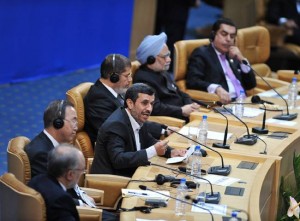The Non-Aligned Movement’s triennial summit in Tehran drew to a close last Friday, leaving mixed messages through which to puzzle.
On the one hand, the summit could be seen as a case study of balance of power in the Middle East. On the other hand, it was a wake-up call for the Iranian regime from the other regional powers.
Little was left off the diplomatic negotiating table last week. From Iran’s nuclear program to the structure of the UN Security Council, to human rights, and the Syrian conflict, world leaders apparently were unafraid to make their presence felt.
Indian Prime Minister, Manmohan Singh brought the largest delegation to Tehran on the heels of a year spent bypassing international trade sanctions with the regime.
UN Secretary General Ban Ki Moon broached several contentious topics with his hosts as well as commenting on the criticism of his visit:
“I think that [the trip] should not have been controversial. As a secretary-general of the United Nations, I have a mandate to engage with all the member states of the United Nations.”
He called on his hosts to comply with five Security Council resolutions that address Iran’s nuclear program, and ending their uranium enrichment program. However, the 120-nation summit declared its support for Iran’s nuclear program and its right to a full nuclear cycle, which means, of course, support for Iran’s right to continue enrichment.
Egyptian president Mohammad Morsy made headlines by accepting Tehran’s invitation to the summit – the first head-of-state level visit from either country in decades – and then promptly excoriating the Syrian regime, Iran’s (purportedly) only Middle Eastern ally, drawing silence from Iranian media, astonishment from its leadership, and anger from the Syrian delegation.
Cairo and Tehran have long claimed the primary leadership roles in the Middle East. Morsy’s visit could be viewed as an assertion of Egypt’s new role in a changing Middle East, a new balancing act, between Tehran, Riyadh, Istanbul and Cairo.
The “contact group” for Syria, proposed by Morsy, includes Iran, Saudi Arabia, Turkey and Egypt as a group of states that can be a part of the solution in Syria. This could offer a middle path between Western (US/Europe) intervention and Eastern (Russia/China) obstruction in Syria.
Morsy’s trip to Beijing prior to his trip to Tehran should have signaled to his hosts that they are not alone in charting an independent course in global politics. However, NAM signaled that if Iran chooses to go it alone in the ME (especially with a sinking Syria), they might get left behind.
Two years into the Arab Spring, a new balance of power paradigm can be seen. The potential for alliances has arguably never been greater, and it seems as if Morsy was conspicuously putting that message on the table.
It was clear from the Tehran Declaration that Syria is a priority, and the Assad regime’s survival is not.
The NAM conference summarily delivered the Iranian leadership its most serious wake-up call.
With the situation in Syria heading desperately south, international sanctions sinking their teeth further into the Iranian economy’s health and a new IAEA report on Iran’s nuclear program, the NAM summit was both an exercise in hospitable camaraderie and a caustic bell toll for the Iranian regime.
Regardless of where Iran goes from the NAM summit, the message from other regional powers was loud and clear: Iran is not alone… yet.
For Western policy makers, the mixed messages of the NAM summit are a cause for both concern and optimism. The attendance of Ban and Morsy helped Iran buck the isolation trend. But the leaders made it clear that if the Iranian regime continues to make enemies within its sphere of influence, the time for alliances will be at an end, and the true isolation will begin.
If Iranian leadership can sort through these mixed messages from the NAM summit, heeding the wake-up call, and taking steps to address the international community’s concerns over its nuclear program, the next round of nuclear negotiations have a chance of success.



